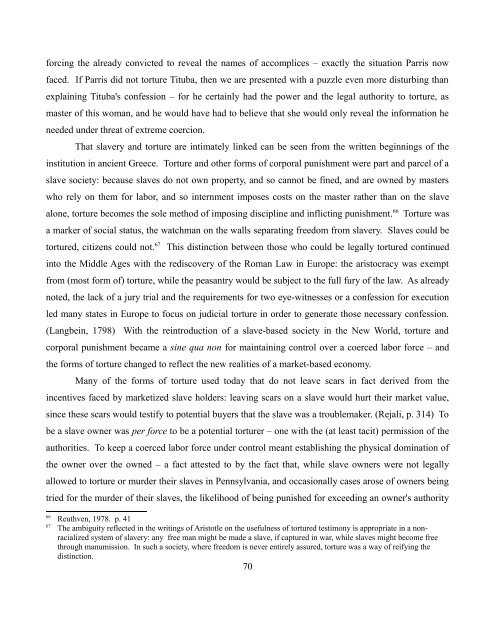The Torturer's Dilemma: Analyzing the Logic of Torture for Information
The Torturer's Dilemma: Analyzing the Logic of Torture for Information
The Torturer's Dilemma: Analyzing the Logic of Torture for Information
Create successful ePaper yourself
Turn your PDF publications into a flip-book with our unique Google optimized e-Paper software.
<strong>for</strong>cing <strong>the</strong> already convicted to reveal <strong>the</strong> names <strong>of</strong> accomplices – exactly <strong>the</strong> situation Parris now<br />
faced. If Parris did not torture Tituba, <strong>the</strong>n we are presented with a puzzle even more disturbing than<br />
explaining Tituba's confession – <strong>for</strong> he certainly had <strong>the</strong> power and <strong>the</strong> legal authority to torture, as<br />
master <strong>of</strong> this woman, and he would have had to believe that she would only reveal <strong>the</strong> in<strong>for</strong>mation he<br />
needed under threat <strong>of</strong> extreme coercion.<br />
That slavery and torture are intimately linked can be seen from <strong>the</strong> written beginnings <strong>of</strong> <strong>the</strong><br />
institution in ancient Greece. <strong>Torture</strong> and o<strong>the</strong>r <strong>for</strong>ms <strong>of</strong> corporal punishment were part and parcel <strong>of</strong> a<br />
slave society: because slaves do not own property, and so cannot be fined, and are owned by masters<br />
who rely on <strong>the</strong>m <strong>for</strong> labor, and so internment imposes costs on <strong>the</strong> master ra<strong>the</strong>r than on <strong>the</strong> slave<br />
alone, torture becomes <strong>the</strong> sole method <strong>of</strong> imposing discipline and inflicting punishment. 66 <strong>Torture</strong> was<br />
a marker <strong>of</strong> social status, <strong>the</strong> watchman on <strong>the</strong> walls separating freedom from slavery. Slaves could be<br />
tortured, citizens could not. 67 This distinction between those who could be legally tortured continued<br />
into <strong>the</strong> Middle Ages with <strong>the</strong> rediscovery <strong>of</strong> <strong>the</strong> Roman Law in Europe: <strong>the</strong> aristocracy was exempt<br />
from (most <strong>for</strong>m <strong>of</strong>) torture, while <strong>the</strong> peasantry would be subject to <strong>the</strong> full fury <strong>of</strong> <strong>the</strong> law. As already<br />
noted, <strong>the</strong> lack <strong>of</strong> a jury trial and <strong>the</strong> requirements <strong>for</strong> two eye-witnesses or a confession <strong>for</strong> execution<br />
led many states in Europe to focus on judicial torture in order to generate those necessary confession.<br />
(Langbein, 1798) With <strong>the</strong> reintroduction <strong>of</strong> a slave-based society in <strong>the</strong> New World, torture and<br />
corporal punishment became a sine qua non <strong>for</strong> maintaining control over a coerced labor <strong>for</strong>ce – and<br />
<strong>the</strong> <strong>for</strong>ms <strong>of</strong> torture changed to reflect <strong>the</strong> new realities <strong>of</strong> a market-based economy.<br />
Many <strong>of</strong> <strong>the</strong> <strong>for</strong>ms <strong>of</strong> torture used today that do not leave scars in fact derived from <strong>the</strong><br />
incentives faced by marketized slave holders: leaving scars on a slave would hurt <strong>the</strong>ir market value,<br />
since <strong>the</strong>se scars would testify to potential buyers that <strong>the</strong> slave was a troublemaker. (Rejali, p. 314) To<br />
be a slave owner was per <strong>for</strong>ce to be a potential torturer – one with <strong>the</strong> (at least tacit) permission <strong>of</strong> <strong>the</strong><br />
authorities. To keep a coerced labor <strong>for</strong>ce under control meant establishing <strong>the</strong> physical domination <strong>of</strong><br />
<strong>the</strong> owner over <strong>the</strong> owned – a fact attested to by <strong>the</strong> fact that, while slave owners were not legally<br />
allowed to torture or murder <strong>the</strong>ir slaves in Pennsylvania, and occasionally cases arose <strong>of</strong> owners being<br />
tried <strong>for</strong> <strong>the</strong> murder <strong>of</strong> <strong>the</strong>ir slaves, <strong>the</strong> likelihood <strong>of</strong> being punished <strong>for</strong> exceeding an owner's authority<br />
66 Reuthven, 1978. p. 41<br />
67 <strong>The</strong> ambiguity reflected in <strong>the</strong> writings <strong>of</strong> Aristotle on <strong>the</strong> usefulness <strong>of</strong> tortured testimony is appropriate in a nonracialized<br />
system <strong>of</strong> slavery: any free man might be made a slave, if captured in war, while slaves might become free<br />
through manumission. In such a society, where freedom is never entirely assured, torture was a way <strong>of</strong> reifying <strong>the</strong><br />
distinction.<br />
70
















